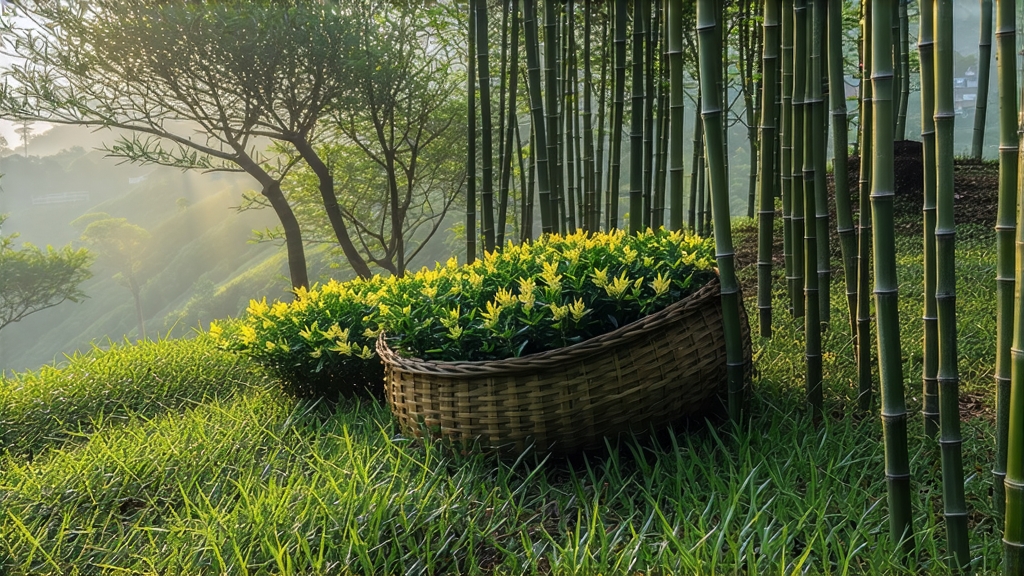
Tucked high on the shoulders of Sichuan’s Meng Ding mountain, where perpetual cloud veils the sun like silk and the Min River murmurs below, a tea once reserved for emperors still unfurls its buttery fragrance each April. Meng Ding Huang Ya—literally “Meng Ding Yellow Bud”—is the least-known member of China’s six great tea families, yet it carries inside each down-covered leaf the genetic memory of Tang-dynasty court etiquette, Song-dynasty poetry contests and Ming-dynasty caravan whistles. To meet it is to step into a hush more golden than green, a flavor that seems to have borrowed the afterglow of sunset and stored it between bud and stem.
History: from palace secret to mountain whisper
The first written record appears in 808 CE, when the Tang emperor Xianzong accepted “Meng Mountain Yellow Tribute” as part of the land-tax reform. Carried by coolies along the Jianmen plank road, the tea traveled eight hundred perilous li to Chang’an, arriving wrapped in bamboo-leaf and lotus fiber. By the Song, Meng Ding’s abbot-monks had refined a “three-yellow” protocol—yellow bud, yellow leaf, yellow liquor—earning the tea a place on the imperial altar during the spring Sheji rites. When Qing merchants shifted their gaze to more profitable dark bricks, Huang Ya retreated into monastic obscurity, surviving only because a handful of hermit-teaists continued to fire small batches for mountain healers. Not until 1959 did a state-led survey rediscover ancient mother trees hidden behind a waterfall; cuttings were propagated, and the cultivar was formally re-registered as a China-famous tea in 1982. Even today total annual yield hovers below fifteen tonnes, making each kilogram a time capsule rather than a commodity.
Micro-terroir: why the mountain itself is the first master
Meng Ding sits at 29.9 °N, 1,450 m above sea level, straddling the edge of the Sichuan basin and the Tibetan plateau. The collision of wet monsoon air with cold plateau winds creates a 280-day fog season; diffused light forces the tea bush to synthesize more theanine and fewer catechins, gifting the leaf its hallmark sweetness. Soils are Devonian quartz sandstone leached by centuries of pine needles, yielding a sandy loam with a pH of 4.7–5.2—ideal for slow, even bud growth. Night temperatures can drop 12 °C within hours, shocking the plant into concentrating aromatic volatiles; locals call this “the mountain’s own withering room.”
Cultivar identity: the fish-hook bud
The traditional cultivar is a Sichuan-specific seedling population named “Meng Ding Xiao Ye Zhong” (small-leaf Meng Ding). Its spring bud is hook-shaped, 18–22 mm long, and covered in a pubescent down that catches light like frost. The bud-to-leaf ratio is 1:0.8, unusually high, meaning one kilogram of finished tea demands between 42,000 and 48,000 individual buds, all plucked before Qingming festival when the morning dew still smells of wild orchid.
Craft: the invisible 48-hour sauna
Yellow tea’s defining step is “sealed yellowing” (men huang), a process that walks the tightrope between green tea’s kill-green and black tea’s oxidation. Immediately after picking, buds are spread on bamboo trays for 70–90 minutes of mountain withering; moisture drops from 76 % to 68 %, edges soften, and a faint grassy note gives way to steamed corn. Next comes a 160 °C wok firing lasting only 90 seconds—just long enough to denature polyphenol oxidase while preserving leaf integrity. The still-warm buds are then wrapped, not in cloth, but in thin layers of fresh pampas grass whose natural enzymes kick-start non-enzymatic browning. Grass bundles are stacked inside a cedar box; temperature is held at 28 °C and humidity at 85 % for two full nights. During this sauna the leaf slowly turns ochre, amino acids convert to aromatic pyrazines, and a mellow “chestnut rice” note emerges. Finally the tea is given a low 60 °C bake for forty minutes to lock in fragrance, then rested for seven days so residual moisture can migrate from stem to tip—an interval locals call “returning the soul.”